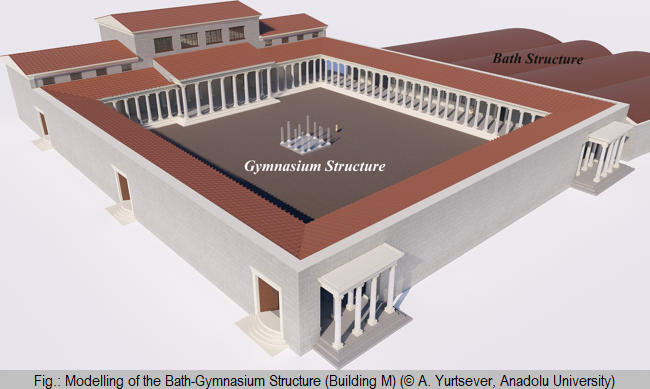The first works were executed by F. Beaufort in 1811, who showed Building M on the city map for the first time. The building was marked on the city plan as a gymnasium by K. Lanckoronski in the publication on the southern coast of Anatolia which was published in 1890.
The first excavation works began in 1949 and were led by A.M. Mansel. The excavations and researches performed from 1949 to 1951 were ended with partial restoration carried out in 1965 under the surveillance of Austrian architect A. Machatschek. Mansel and M. Wegner dated the structure to the era of Antonines (Late Antonines Era, 166-192 A.D.). However, recent researches have demonstrated that Building M is constructed in front of the northern walls of the public bath structure situated in the south. Thus, a bath-gymnasium structure complex was created before 150 A.D. The indoor places behind the Eastern Stoa of the structure are designed as special places. The Northern and Southern Places were formed as places where young athletes got undressed or which fulfilled cult function such as “Bankettsaal” or ephebeion and the the "Kaisersaal" was decorated for propaganda of the city (Fig.).

Many different comments have been made on the function of Building M. It was generally discussed that the structure could be a gymnasium, but Mansel’s thoughts that the structure was a State Agora have been accepted by the world of science. The public bath structure detected for the first time in the south of Building M resulted in the fact that one should approach with caution to the ideas that the structure is a State Agora. A significant discussion that the structure could be a “bath-gymnasium building complex” started in the later process.
Noteworthy findings were found in the studies of architectural documentation related to the structure. The first one of those findings is the headwall section of the furnace of the public bath detected in the western section of the Southern Stoa. Upon detection of the headwall, existence of a public bath in the south of Building M was definitely revealed. Consequently, the places of the in-line type public bath group were named from the west to the east as follows: caldarium, tepidarium, frigidarium and praefurnium/laconicum. Among those places, only apodyterium/laconicum was the one which was transformed into basilica thermarum in the late 4th century – early 5th century A.D. The result of all these studies shows that the building is a bath-gymnasium structure. The definition of state agora or Building M is now wrong.![]() © Adem Yurtsever
© Adem Yurtsever
e-mail: ayurtsever@anadolu.edu.tr
This article should be cited like this: A. Yurtsever, Building M at Side in Pamphylia, Forum Archaeologiae 94/III/2020 (http://farch.net).